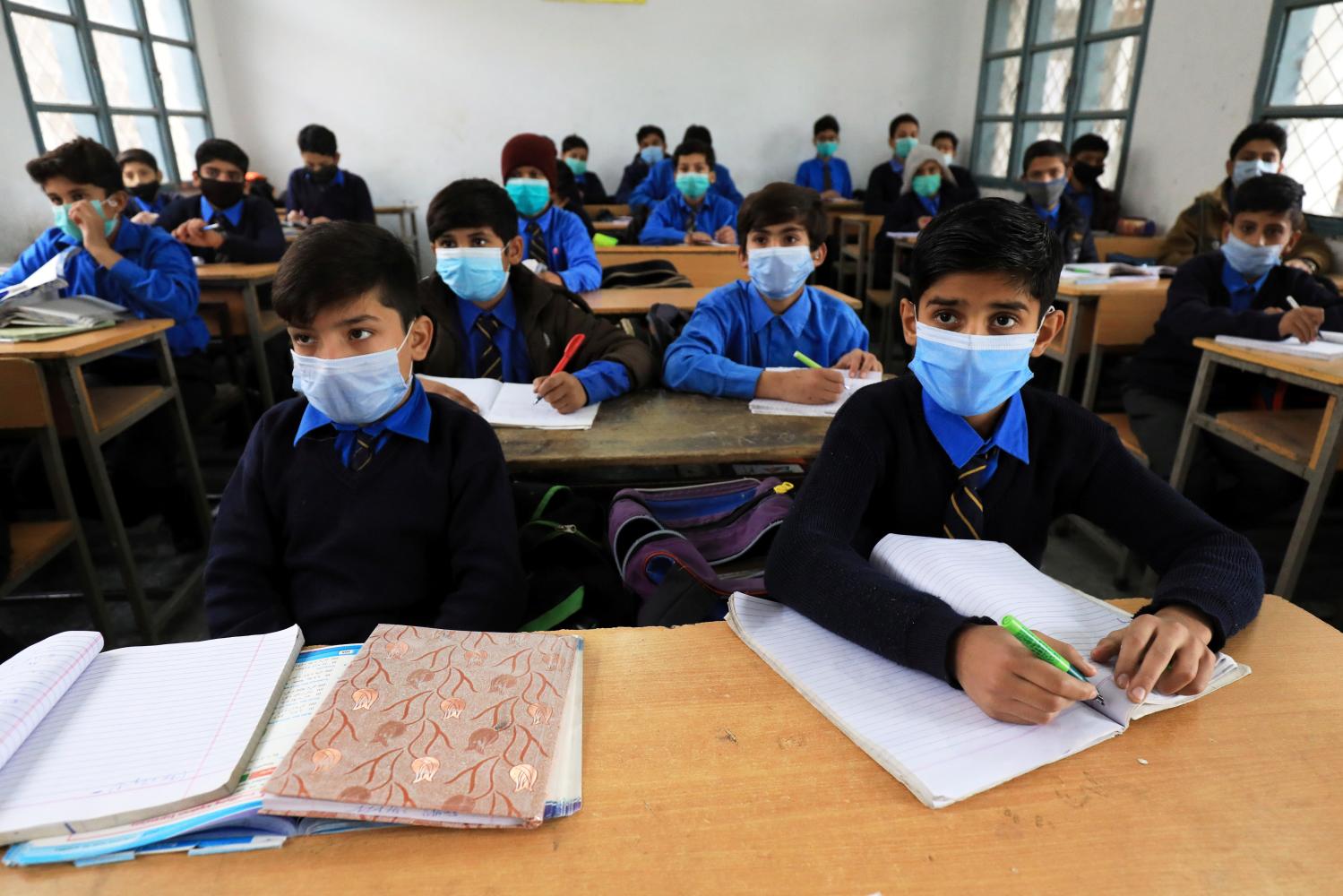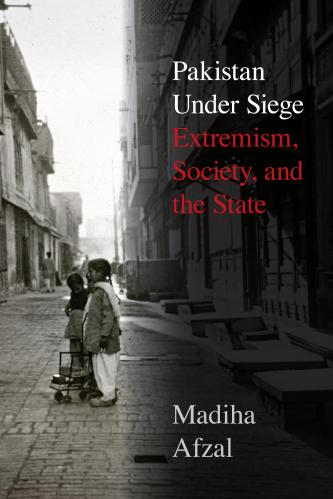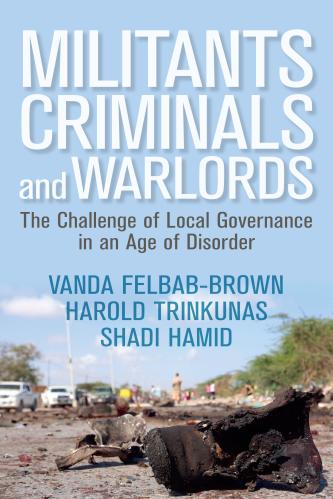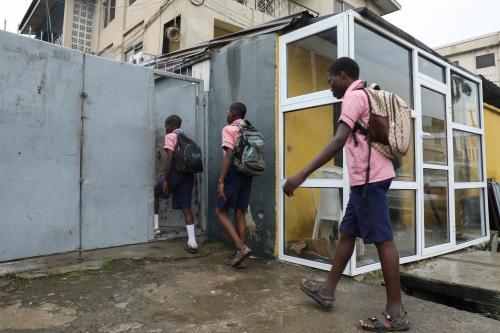This brief is part of the Brookings Blueprints for American Renewal & Prosperity project.
Contents
- Summary
- Challenge
- A review of Obama and Trump administration policies
- Policy recommendations
- Conclusion
Summary
This brief argues that we should productively use the current moment of reckoning with the post-9/11 era to redefine our paradigm for countering extremism and terrorism around the world in a manner that is both comprehensive and cost-effective.
Taking stock 20 years after the attacks of September 11, 2001, it is clear that the global position of al-Qaida and the Islamic State group (IS) has weakened, owing to successful (and enormously costly) counterterrorism efforts led by the United States. Yet other groups that are more locally and regionally focused, in many cases splinters of al-Qaida and IS, are resurging or ascendant. Terrorism remains a problem around the world, and the extremism that fuels it remains largely unaddressed.
Efforts undertaken to counter extremism over the last 20 years were belated when they began, and were never as concerted as the effort to counter terrorism.
Efforts undertaken to counter extremism over the last 20 years were belated when they began, and were never as concerted as the effort to counter terrorism. They were also fragmented and focused on a bottom-up approach, when research informs us that extremism is in many ways driven from the top down, via country-level education systems, laws, and politics.
This Blueprint therefore proposes a new paradigm for countering extremism, based on a top-down, country-level approach that focuses on education and equipping citizens with critical thinking skills to counter extremist propaganda. To be specific, I propose a U.S.-led, United Nations-centered, global effort to counter extremism through education and the media. One way to operationalize this would be to have member states sign a U.N. convention on education and extremism, and have them, under that framework, reach an agreement according to which signatory countries would commit to making formal education systems and media compliant with a set of guidelines — including removing hate material from curricula and teaching tolerance, teaching critical thinking, teaching how to counter extremist propaganda, and teaching how to decipher the credibility of information seen or received through both mainstream and social media. The benefits of this approach would extend to countering all forms of extremism.
Challenge
Nineteen years after the attacks on September 11, 2001 and the declaration of the subsequent U.S.-led “war on terror,” the devastation wrought by the global coronavirus pandemic has forced an American reckoning with the post-9/11 era. This reckoning had already begun in recent years, with the effort to wind down the “forever wars,” especially the war in Afghanistan, and a consideration of the enormous costs — in lives and money — that they have entailed. That the daily domestic death toll of the pandemic has been consistently exceeding that of the 9/11 attacks, puts the concern into sharp relief — as do the events of January 6, with pro-Trump extremists staging an insurrection at the U.S. Capitol — lending an urgency to the desire to turn the page. The underlying argument is that we should focus instead on long-ignored and urgent domestic problems — socioeconomic inequality, persistent racism and the threat of white supremacy, preparing for the next pandemic — and contend with other pressing foreign policy concerns, including the rise of China.
But with this urgency, there is a danger that we will move on without absorbing the lessons learned from the last two decades — and perhaps worse, shelving lessons yet unlearned — and without a concerted approach to tackling the twin problems of terrorism and extremism, which remain significant globally. In 2019, nearly 8,500 terrorist attacks took place around the world, almost the same number as in 2012. What’s more, the extremism and ideologies that fuel these attacks remain intact. This brief argues that we should productively use the current moment of reckoning with the post-9/11 era to redefine our paradigm for countering extremism and terrorism around the world in a manner that is both comprehensive and cost-effective.
Over the past two decades, American efforts have focused disproportionately on countering terror — and have seen success in protecting the U.S. homeland. But the effort at countering violent extremism (CVE), when it finally began during the second Obama administration, was belated, and based on a bottom-up approach that was piecemeal, fragmented, and ultimately insufficient to counter extremism in any comprehensive way. This Blueprint proposes a new paradigm for countering extremism, based on a top-down, state-level approach that focuses on education and equipping citizens with critical thinking skills to counter extremist propaganda. This is based on research across contexts which shows that the most important policies that affect attitudes and can lead to extremism are driven from the top down — via education systems, laws, and politics — and not the bottom up.
I recommend reform of national education policies to counter extremism, but recognize that targeting specific countries, or using bilateral approaches, is a non-starter. Therefore, I propose a U.S.-led, United Nations-centered, global effort to counter extremism through formal education and the media. One proposal to operationalize this would be to have member states sign a U.N. convention on education and extremism, and have them, under that framework, reach an agreement according to which signatory countries would commit to making education systems and media compliant with a set of guidelines. This approach, ambitious though it is, would be analogous to that followed by the Paris agreement to counter climate change. One could use a less transformative model as well, such as subsuming these guidelines and recommendations under the education goal of the Sustainable Development Goals, but that less visible approach could prove less effective. The positive externalities of focusing on education would extend beyond their effect on extremism: This would also counter disinformation campaigns and the phenomenon of fake news, and the effect on attitudes could in turn have far-reaching effects on various forms of violence.
One note — the arguments made here are based on research on jihadist extremism, but the solutions proposed are universal, and apply to other forms of extremism, including right-wing extremism in the United States, as well.
Assessing the jihadist threat around the world
The exact total cost of the post-9/11 wars to date is disputed, but the upper-bound estimate, from the Costs of War project at Brown University, posits that the wars in Iraq and Afghanistan and money spent on homeland security have cost the United States $6.4 trillion through 2019. If that is an overestimate, it is difficult to argue that the amount spent isn’t at least half that number. If success can be measured in terms of preventing a large-scale terrorist attack on the United States, the huge resources expended on counterterrorism, intelligence and the homeland security architecture after the attacks of September 11 have yielded results: just over 100 people have been killed in jihadist attacks in the United States since then.
Al-Qaida as an organization is far weaker than it once was, owing to U.S. counterterrorism operations in Afghanistan and Pakistan — including as many as 540 targeted drone strikes during the Obama administration. While the ungoverned vacuum left in Iraq led to the rise of the Islamic State group (IS), the concerted fight against it begun by the Obama administration and continued during the Trump presidency largely dismantled its “caliphate.” U.S. and international efforts in response to IS’s recruitment of foreign fighters have severely hindered the ability of foreign fighters to travel and thus of terrorist organizations to recruit them. Osama bin Laden and Abu Bakr al-Baghdadi have been killed. A key al-Qaida leader, Abu Muhammad al-Masri, was killed in Iran in an Israeli spy operation in August 2020.
The fiscal costs of all of this to the United States have been extraordinary, and the loss of life significant, but the American homeland is, for now, undeniably safer. With the fall of the IS “caliphate” and the decimation of al-Qaida’s leadership, the major terrorist threat the United States faces domestically is no longer jihadist, but white supremacist. Indeed, those who contend that the war on terror must no longer occupy a central position in our national priorities point to the fact that the direct jihadist threat to the U.S. has abated. (In December, though, the Trump administration dismantled a Pentagon office focused on IS, a worrying action that may have led to gaps in the provision of counterterrorism information to the incoming administration).
Yet jihadist terrorism remains a significant problem globally, including from regional al-Qaida and IS affiliates that have proven lethal to their local populations. Two devastating terrorist attacks on the same day in November 2020 in Vienna and Kabul attest to this. On the morning of November 2, 2020, three gunmen stormed Kabul University, one of the oldest universities in Afghanistan, killing 35 students and professors. Sixteen of the students killed were studying policy and public administration, hoping to help build their country’s future. A local IS affiliate, Islamic State – Khorasan Province (IS-K), claimed responsibility for the attack. In Vienna, Austria that evening, a 20-year old man shot and killed four people in a crowded district; he had been convicted of attempting to join IS in the past. IS claimed responsibility for his attack.
Al-Qaida still survives in Afghanistan, and recent reports have noted its resilience; a spate of al-Qaida leaders was killed in special operations in Afghanistan and Syria during the last week of October 2020. Regional affiliates, including al-Shabab in Somalia, operate from the Maghreb to East Asia. Al-Qaida in the Arabian Peninsula (AQAP) claimed an attack on the Pensacola naval air base in Florida in December 2019.
The Taliban, which gave haven to al-Qaida in Afghanistan in the run up to 2001, is now a legitimate political actor domestically in that country and internationally, having militarily held off the United States and signed a peace deal with it in February 2020. It is at its most powerful since 2001. Despite the main condition of the U.S.-Taliban deal signed in Doha for the Taliban being counterterrorism commitments in exchange for a complete American withdrawal, the U.N. reports that the Taliban has not cut ties with al-Qaida. It is also worth noting that the Doha deal, seen in the region as a victory for the Taliban and as “America’s surrender,” is perceived as a boon to the jihadist movement at large. Al-Qaida said the deal signified the “enemy acknowledging its defeat” and congratulated the Taliban on its “great victory” over America and its allies.
In Nigeria, the terrorist group Boko Haram has waged a deadly insurgency in the country’s northeast since 2009, and in recent years in the Lake Chad region at the meeting point of Nigeria, Chad, Cameroon, and Niger. A splinter group, the Islamic State West Africa Province (ISWAP), declared allegiance to IS in 2015. It is Boko Haram’s more brutal faction. Boko Haram and ISWAP have inflicted more violence on state actors in Nigeria since 2018 than at any other point in the insurgency.
The Pakistani Taliban (also known as the Tehreek-e-Taliban Pakistan, or TTP) killed tens of thousands of Pakistanis between 2007 and 2015, using Pakistan’s alliance with the U.S. in its war in Afghanistan as justification for its insurgency. The TTP was in retreat after an extensive Pakistani military operation that began against it in 2014, but has reconsolidated and reemerged in 2020 in its former strongholds in the country’s northwest. TTP militants killed at least 40 Pakistani soldiers between March and September 2020.
Finally, attacks by individual actors who draw inspiration from global jihadist groups — lone wolves — have continued in the U.S. and Europe. In October, an attacker at the Notre Dame church in Nice, France, killed 3, in the aftermath of the publication of cartoons of the Prophet Muhammad by the magazine Charlie Hebdo. (The investigation is ongoing, but no credible group has yet claimed responsibility for the attack, leading to speculation that the attack was inspired and not directed.)
Taking stock, the position of core al-Qaida and IS, terrorist groups that focus on a global jihad — and thus pose a direct threat to the United States — has weakened. Other groups that are more locally and regionally focused, in many cases splinters of al-Qaida and IS, are resurging or ascendant. There are factions and differences within the jihadist movement; there is no one leader it looks to, as it did to bin Laden, and later Baghdadi to an extent.
Yet the ideological overlap across various jihadist groups remains, and fighters often cross from one group to the other. In Pakistan, they switched from the Afghan jihad to the Kashmir-focused jihad in the 1990s. Those Talibs who are unhappy with the U.S.-Taliban deal are now being recruited by its rival, IS-K. In assessing threats to the United States, we cannot rule out local and regional terrorist actors that can cross lines to boost groups that may directly target America.
The question of extremism
Extremism and terrorism are twin problems: extremism can lead directly to violence and it also gives terrorist groups oxygen by providing them an environment for survival, in terms of logistical and financial support, potential recruits, and most broadly, ideological space. Yet while significant resources have been spent on countering terrorism, the project of understanding and tackling the root causes of jihadist extremism around the world largely remains incomplete.
There are several questions relevant to understanding extremism: who becomes a terrorist, and what leads people to support terrorist groups? Considerable attention was paid to this topic in the aftermath of 9/11. The initial conventional wisdom — that the poor and uneducated become terrorists and support terrorist groups — was debunked, and replaced with an amalgam of correlates of extremism, often not lending themselves to quick resolution or simple explanation: grievance, alienation, deficiencies in human rights, lack of political representation. Not enough attention was paid to the ideological appeal of jihadism. Neither was there a focus on understanding attitudes on a spectrum of extremism to violent extremism. The Obama administration’s approach to CVE, as the name suggests, only looked at the latter. It thus missed the structure and determinants of non-violent support —logistical, ideological, and financial — for extremist groups.
In interdisciplinary research on views on the Pakistan Taliban and Boko Haram, I have studied what drove support for these groups among the population in Pakistan and Nigeria respectively, and how it relates to education. In my work on Pakistan, I found that extremism in the population is driven by the decisions taken by the Pakistani state. The state’s curricula, its laws, and its politics have fostered in its citizens a worldview that aligns with terrorist group propaganda and thus makes them vulnerable to it. The Pakistani government education system, in particular, is a vehicle used to impart a biased, one-sided view of the world, one that victimizes Pakistan and places the blame for its problems on the rest of the world and fosters an “us-versus-them” mindset. This, I found, is a particular problem in high school history textbooks — in which information is presented without sources, and a one-sided historical narrative with half-truths and errors is presented as fact. Schooling in Pakistan focuses on rote memorization and does not teach critical thinking, which would allow students to recognize and counter propaganda when they see it. As a result, when Pakistanis encounter extremist propaganda, in many ways consistent with the exclusionary view of the world they find in their history textbooks, they buy into it. In interviews I conducted in Pakistani high schools, I met two students with views sympathetic to an extremist group who had been influenced directly by fundamentalist propaganda from that group, and found themselves unable to counter it. Other students had bought wholesale into videos or photos they had seen online which purported to show people being trained in America to attack Pakistan, a conspiracy theory.
Bangladesh, a country similar to Pakistan (and once its eastern half), offers a striking counter to Pakistan in terms of the prevalence of extremism and terrorism in the country. I’d argue it is the decisions taken by the Bangladeshi state that have ensured extremism remains checked in the country, from the structure of the constitution to its politics and education system. In a non-democratic context, Morocco also provides an example of how much the state matters: its monarchy ensures — often heavy-handedly — the espousal of a “tolerant” Islam in the population.
In the Nigerian case, I found that citizens’ support for Boko Haram rests on grievances in Nigeria’s north against the state-imposed Western system of education — one seen as insufficiently representative and responsible for the north’s backwardness (because it was imposed on an unfamiliar population after independence as part of Nigeria’s “federal character”) — and associated with the elite’s corruption.
In each of these contexts, formal education systems and curricula — in particular, those in secondary or high school – play a large role in defining attitudes in the population. (University education, I found, was less of a problem, and also countered the problematic curricula taught in high school.) Education policy, of course, is entirely endogenous, and is determined by any country’s notions of nationalism and identity. The education system can also be a clear venue and indeed the tool to address the roots of extremism and violent extremism, by promoting tolerance and teaching critical thinking.
Both Pakistan and Nigeria have focused on defeating terrorist groups militarily, and have left the roots of extremism in their countries unaddressed. This helps explain the stubborn resilience and resurgence of the TTP and Boko Haram despite military attempts to defeat them — and why those attempts succeeded only temporarily.
Closely connected to identifying the root causes of extremism is the question of the ideological appeal of jihadism: an ideology which typically centers around establishing a stringent Islamic system of governing — whether across countries or more locally — and emphasizes an existential opposition to Western values and policies (though with Donald Trump’s presidency and the rise of China, the focus on targeting America as a superpower to be attacked may have lost some of its ideological appeal). As I mentioned above, in many ways such ideological propaganda was consistent with the worldview presented in Pakistani textbooks. The Obama administration’s CVE approach focused on counter-messaging against extremist propaganda and on making it harder to access it, including by targeting group messaging apps such as Telegram. Yet there is still a preponderance of fake news and conspiracy theories — of all forms, but especially on social media and on messaging platforms such as WhatsApp, etc. — that serve the purposes of extremist propaganda. One way that extremism can be countered is if individuals are able to identify such misinformation when they receive it. This can be accomplished by teaching students the ability to evaluate information based on its sources, and critical thinking skills in schools. The applicability of this approach to countering right-wing extremism in the United States should also be clear.
A review of Obama and Trump administration policies
In a 2016 piece calling for more attention to be paid to efforts to counter extremism, Michael Morell, Sandy Winnefeld, and Samantha Vinograd, senior intelligence, defense, and national security officials in the Obama administration, wrote that countering violent extremism “efforts have paled in comparison to our ‘hard’ counter-terrorism operation”:
“For every 1,000 hours we spent in the Situation Room talking about how to stop existing extremists from attacking us, we spent perhaps one hour talking about how to prevent the creation of terrorists in the first place. And, for every million dollars the U.S. government spent on stopping those trying to attack us, we spent perhaps one dollar on countering radical extremism.”
During the second Obama administration, there was a flurry of activity on CVE on the part of both the State Department and the White House. A White House Summit was held in February 2015, and a Leaders’ Summit was held in New York City in September 2015 with representatives from multilateral institutions and governments and civil society organizations around the world. The key themes around the CVE approach were that it should be centered at the local, community level, identifying communities vulnerable to extremism; that local leaders — and governments and civil society organizations — should be involved in tailored interventions; and that there needed to be a focus on building resilience. Youth engagement was a key component, and there was a call for women to be involved in CVE efforts.
But what did all of this really mean? Behind a well-intentioned effort and sensible-sounding concepts, this approach did not clearly identify the drivers of extremism beyond recognizing that grievance was important. And ultimately, by concentrating on the ground up, it missed the fact that the most important policies that affect attitudes in the broad population are driven from the top down — via education systems, laws, and politics.
Anything else — focusing on local or grassroots or community-level interventions — is missing the forest for the trees, or taking action that is too piecemeal and narrowly targeted, akin to putting out small individual fires.
President Barack Obama recognized the importance of country-level factors during his speech at the White House summit, where he said: “When governments oppress their people, deny human rights, stifle dissent or marginalize ethnic and religious groups, or favor certain religious groups over others, it sows the seeds of extremism and violence.” Despite that recognition, the focus of CVE efforts remained a grassroots one — perhaps partly out of pragmatism and a recognition that this approach would be more palatable than to have governments sign up for a wholesale reconfiguration. The administration’s CVE efforts also lumped thinking about homegrown threats with thinking about international and regional threats.
This approach focused on putting on the brakes on at the cusp of violence (by definition), and not earlier on the extremism spectrum; it also included deradicalization by incorporating reintegration and rehabilitation programs for former extremists. All of this is necessarily costly and fragmented. The focus in many ways was on treatment, rather than prevention. Domestically, the approach also faced criticism that it singled out Muslim communities for surveillance and looked upon them with suspicion.
The Trump administration didn’t fully dismantle the Obama administration’s CVE approach, but it did not follow through on it either. It did away with the term CVE — which it considered too “politically correct” — and replaced it in terms of rhetoric with “radical Islamic terrorism,” and on paper with counterterrorism. The Trump administration’s counterterrorism strategy in 2018, though, did acknowledge the importance of prevention “to thwart terrorist radicalization and recruitment,” adding that “prevention works.” The Trump approach ultimately was characterized more by “a lack of consistent leadership, strategy, coordination, coherence, and prioritization” than a systematic dismantling of the Obama strategy. The Obama CVE policy thus essentially stalled during the Trump presidency.
All in all, the U.S. approach to CVE resulted in an effort in which the whole did not add up to the sum of its parts, which focused on the wrong level, and which ultimately never really took off.
Policy recommendations
The main recommendation of this paper is a proposal to comprehensively address the root causes of extremism, especially as they relate to the early stages of the extremism spectrum, such that we can effectively block the later stages from developing. Crucially, it is an approach in which the main costs need not be directly borne by America.
Firstly, I propose reform of national education policies — focusing on formal schooling systems, specifically history curricula in elementary and secondary schools — to counter extremism. Country legal systems could be another potential target — say blasphemy laws — but those are all but impossible to change, as the Pakistani case makes clear. Education may be the most practical place to begin reform, but it is still likely to receive pushback. Curriculum reform flies in the face of countries wanting to use their education systems to inculcate their own sense of nationalism, sometimes narrowly defined and exclusionary, which in turn can sow the seeds for extremism. There is a reason those countries choose the curricula they do — it is in service to their own nationalism. This recommendation thus needs to be operationalized not bilaterally, nor by focusing on specific countries — which would receive clear backlash for being a “Western agenda” — but by working through the United Nations with its unique platform to bring countries around the world on board.
The biggest hurdle would be for the states to recognize with urgency that formal education is key to addressing extremism — it can foster it, and conversely, is the key tool to counter it — and that the benefits of ratifying this agreement would accrue to the states themselves.
The best model to follow might be the Paris agreement to counter climate change, which was signed in 2016 within the United Nations Framework Convention on Climate Change. The goal would be near universal membership of a parallel U.N. convention on education, and an agreement reached according to which signatory countries would commit to making educational systems compliant with a set of guidelines. The biggest hurdle would be for the states to recognize with urgency that formal education is key to addressing extremism — it can foster it, and conversely, is the key tool to counter it — and that the benefits of ratifying this agreement would accrue to the states themselves (with positive externalities for others).
The way could be led by the developed world, including by the United States, but any bloc of countries could join the U.S. in being initial signatories. Within the U.S. government, the State Department could lead the charge on this work.
This agreement would include countries committing to a full audit of national and subnational curricula (given that curriculum formation may be a subnational responsibility) in elementary and secondary education, to removing hate material and teaching tolerance, to teaching critical thinking, to teaching how to counter extremist propaganda, and to teaching how to determine the credibility of information seen or received through both mainstream and social media. History, social studies, and civics curricula should be a central focus, but intolerance and propaganda can seep in across subjects, including in language curricula. The education component of this should extend beyond formal education to adult education, potentially through the media, with education campaigns on television and in print. A television ad campaign could, for instance, teach citizens what “fake news” looks like and how to recognize it. The externalities would extend beyond countering extremism to being able to recognize and counter all manner of disinformation campaigns.
The U.N. Security Council has put forward a number of resolutions over the past decade to deal with extremism and terrorism, including on CVE (incorporating some of the same bottom-up community-led initiatives the Obama administration had proposed in its CVE strategy), but resolutions limit themselves to “encouraging” or “urging” member states to take action. My proposed approach of an agreement within a U.N. framework would, by definition, go further and would require signatories to commit to taking action.
There would be another element to this agreement, which would require investment in country-level research to understand how each country’s particular education system might foster extremism and might be improved, so that tailored solutions can be employed. The United Nations Educational, Scientific and Cultural Organization (UNESCO) could also potentially develop a proposed curriculum framework to be adopted by countries. Much as in the Paris agreement, one component would ensure transparency, implementation, and compliance from the signatories.
A less ambitious, less visible version, but perhaps more easily doable, would be to subsume this under the Sustainable Development Goal on education. SDG 4 on quality education has a specific component, 4.7, which already begins to address this:
“By 2030, ensure that all learners acquire the knowledge and skills needed to promote sustainable development, including, among others, through education for sustainable development and sustainable lifestyles, human rights, gender equality, promotion of a culture of peace and non-violence, global citizenship and appreciation of cultural diversity and of culture’s contribution to sustainable development.”
However, the disadvantage of a less visible approach is that it may be less likely to be implemented.
In addition, to counter regional and local terrorist groups — and to do so in a cost-effective, non-military manner as much as possible, in keeping with reducing the budget allocated to international counterterrorism efforts — I propose a second policy tool. U.S.-led action at the Financial Action Task Force (FATF) — a multilateral body which can place a country on a “grey list” for enhanced monitoring for terrorist financing, that in turn hinders foreign investment into the country — has been effective in recent years in encouraging Pakistan to act against militant groups such as the Lashkar-e-Taiba (the FATF listing has worked better to induce Pakistan to take action than using U.S. aid as a carrot). Beyond America being directly involved in counterterrorism (at great cost), this is an effective tool that places the onus and the cost on the countries themselves to take action against militant groups. It can be used far more widely to target local and regional terrorist groups that do not pose a clear threat to America.
Wide, systematic FATF targeting across countries would also counter worries from states like Pakistan who argue that their FATF status changes are politically motivated and perceive them to be unfair. America can take the lead on this front, but would have the cover of a multilateral body as the implementer.
Conclusion
In our current moment of reckoning with the post-9/11 era in the wake of a global pandemic and the threat of domestic right-wing extremism, it would be a mistake to turn away from the lessons of the last two decades on fighting extremism and terrorism around the world. Instead, we have an opportunity to redefine our paradigm for countering extremism and terrorism, and to do so at once comprehensively and cost-effectively: through leading the way on an international shift in education systems and curricula, and doing so as we reengage with the world in the Biden administration. We should take up the challenge.
-
Acknowledgements and disclosures
Many thanks to Michael O’Hanlon and Natan Sachs for thoughtful feedback and suggestions, to Jeff Feltman for a helpful discussion, and to Ted Reinert for excellent editing.











